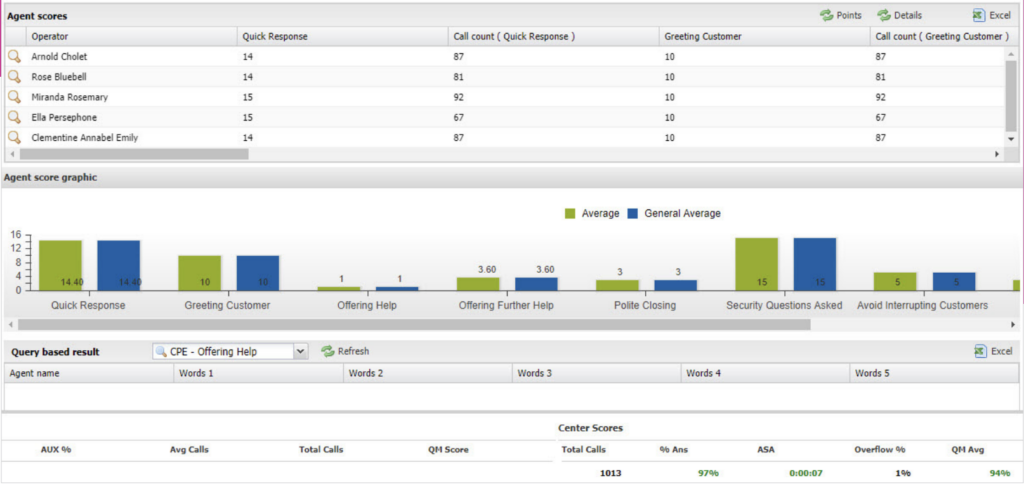- Written by Stuart Green - Account Director
- Connect with Stuart on LinkedIn
If you look at the marketing materials of most contact centre vendors, you’ll see speech analytics insights as the shining light. It’s got the most graphs and charts and is thrust upon you because of its visual nature. But what can you actually learn from speech analytics? Let’s start at the beginning to make sure we’re on the same page.
What is meant by speech analytics?
Speech analytics is the result of all the calls you receive in your contact centre. Every time a customer interacts with an agent, algorithms and artificial intelligence (AI) are working away behind the scenes to provide insight into how that call went.
The output is typically a real-time or historical report, repurposed into graphs and visuals to make the data easy to digest.

What are the insights of voice analytics?
When you implement voice analytics, expect to get the following information:
Trigger words: Highlight what words and phrases cause emotion and derail calls.
Real-time supervisor intervention: Notifications flagging a supervisor needs to take over a call in progress.
Time of day analysis: Find out when customers are happy versus frustrated.
Sentiment analysis: Interpreting language and voice inflection, you can understand how customers are feeling on a call; whether they become agitated or upset as the call progresses.
Quality assurance: Ensure script adherence without reviewing every single call.
Repeated topics: Uncover FAQs and underlying problems with your product to feedback to product and marketing teams.
Cross-sell and upsell opportunities: Flag to agents the ideal time to push a new product or upgrade based on the conversation progress.
When combined, you’ve got an analytics module providing you valuable insight into the inner workings of your contact centre.Some may find this overwhelming to manage. That’s where it’s important to understand the metrics associated with speech analytics.
What are the metrics of speech analytics?
If you’re using speech analytics for the first time, you’ll need a high level and low level view of the data and insight you’re receiving.
Consider tracking the follow metrics on your call centre dashboard:
- Average handle time: There may be a correlation between the length of calls and how your customers respond and react. The longer an interaction, the more frustrated customers can get.
- Customer sentiment score: Track overall sentiment scores to establish a benchmark. Review calls that drop below your “good” threshold.
- Quality management score: Automate agent performance scoring across a subset of categories like active listening, first call resolution, and sentiment.
- Customer satisfaction score: Conduct regular surveys to understand how speech analytics are improving customer experiences.
- Script adherence: Automate yes/no criteria evaluation to ensure agents are following protocols and providing a consistent customer experience.
- Compliance adherence: Automate yes/no criteria evaluation to ensure account access and payments are conducted following set regulations and guidance.
Note: Finance companies can automate the identity and verification process using AI.
Average handle time
There may be a correlation between the length of calls and how your customers respond and react.
Customer sentiment score
Track overall sentiment scores to establish a benchmark. Review calls that drop below your “good” threshold.
Quality management score
Automate agent performance scoring across a subset of categories like active listening, first call resolution, and sentiment.
Customer satisfaction score
Conduct regular surveys to understand how speech analytics are improving customer experiences.
Script adherence
Automate yes/no criteria evaluation to ensure agents are following protocols and providing a consistent customer experience.
Compliance adherence
Automate yes/no criteria evaluation to ensure account access and payments are conducted following set regulations and guidance.
How do you evaluate speech analytics?
So, you know what types of speech analytics insights you can gain and you know the metrics to track them. But how do you know if speech analytics is working for you? Ultimately, you’ll see a major difference across your metrics:
- Agents will be performing better thanks to coaching and training.
- Sales figures will be flying with add-ons and post-sale upgrades.
- Customers will be happier thanks to your on-the-spot diffusion of situations and faster response times.
From a holistic view, you’ll have a dashboard of colour-coded performance analytics that highlight the differences from your before state and your current state. We’re confident the line graphs will be heading to the top right and red has made its way to green.
Which finance companies are using speech analytics today?
You won’t be the first finance company to foray into the world of speech analytics. Far from it.
Thanks to the implementation of speech analytics, First Central, one of the biggest motor insurance providers in the UK and a client of ours, analyses its 3.75 million minutes of phone calls inbound every month via speech analytics.
Imagine the time taken to sift through even 10% of those call recordings to find out where there are gaps in your process.
With automatic sentiment analysis and keyword highlighting, First Central can extract learning material with the click of a button. “Great” and “Poor” calls are categorised so supervisors have an on-demand library for training. Agents have learned when to push relevant add-on products.
Through our deployments for finance brands like One Family, Courtiers, and Westminster Wealth Management, we’ve learned what it takes to level-up finance contact centres with speech analytics and AI.
Download our guide exploring AI driven contact centres for FinServ businesses
Discover the current industry views on AI within FinServ, the use cases for AI and take a look at which companies are successfully using it and how AI is delivering value.



